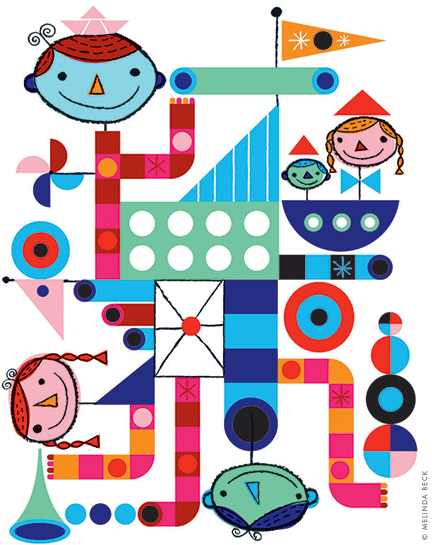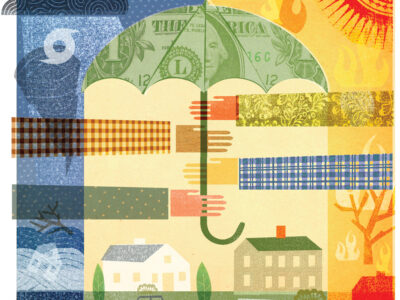
American cities are betting big on leisure and playtime—but actual playgrounds have been left behind.
By Susan G. Solomon | Today’s cities offer tons of amenities that make family life exciting and affordable. From bike-share programs to food trucks, and parklets to free- or reduced-admission days at museums, American city-dwellers have rarely had so much fun at their fingertips. Yet this urban renaissance has largely left one important area behind: playgrounds. It’s not that we lack them, but that so many of the ones we have—even those that have undergone rehabilitation in recent years—offer very little bang for the buck, and too frequently foster boredom more readily than delight. Simply put, American playgrounds are in dire need of reinvention.
Consider the typical American playground. A hulking piece of plastic or metal equipment dominates a dull expanse of poured-in-place rubber surfacing, often enclosed by a menacingly high fence. The main attraction, such as it is, directs youngsters to go up steps, scamper across a horizontal surface, slide down a tube or chute. Whereupon they may then repeat the same process all over again. And again. Kids quickly age out of this predictable environment, where they can’t alter anything and there is no reason to work with peers. No wonder these caged islands are so often forlorn and empty; they completely fail to respond to the needs of children or their communities. Sadly, cities often invest one or two million dollars in attempts to upgrade these spaces—only to end up simply replicating earlier models, with purchased equipment that is rarely sustainable and has an average life expectancy of 15 years.
The typical American play space sends a message to children that we don’t trust them to act thoughtfully and cautiously. Not long ago the editors of an education journal were moved to ask: “Should the dominant image of the child be one of vulnerability or competence?” Our playgrounds—cordoned off spaces that are meant to contain and restrain children—suggest a society dedicated to the former. Guided by low maintenance costs and a policy of “zero injury”—even a scraped knee is seen as an inexcusable event—our playgrounds have eliminated personal exploration and chances for social development. Kids can maneuver all too easily on the equipment; there are no struggles, and consequently no real triumphs. Even the lurid and unnatural colors seem to scream to children that this is a jolly setting; the color choices seem to say that the play structure has already created the fun. Kids are not trusted to produce their own joy.
We need to think audaciously about playgrounds, reconfiguring their concept and their design. We should begin to consider playgrounds as community hubs, places where adults (even those without kids) and children can come repeatedly and spend time together. Playgrounds should be arenas of discovery and camaraderie. Kids should know them as places where activities are participatory, interactive, and open-ended. We have to fight old myths, including the (overwhelmingly unsupported) notions that there are strangers lying in wait to lure our children out of playgrounds; that sand is filled with menacing hypodermic needles; and that rubber safety surfacing, which can double the cost of a play site, is the only acceptable ground cover.
In order to revitalize playgrounds, the people who commission them—and those who design them—need to realize that it is no longer sufficient to say children “need play.” That discussion, while critically significant in other ways, prolongs the reproduction of the playgrounds we already have. We should, instead, focus on what kids need to thrive. What factors affect how children mature emotionally, socially, culturally? What types of experiences will help them become competent adults? How do we provide unpredictable daily occurrences that will enable kids to think through unexpected challenges? How can we prepare them to engage with a future we cannot envision?
Data drawn from the behavioral sciences (and, to a lesser degree, from the neurosciences) provide useful insights that should inform playground design. Current findings indicate that children should have as many varied and broad opportunities as possible. They benefit from possibilities to demonstrate authentic mastery (which carry the possibility of failing on the way to success); exercise executive function (planning, problem solving, juggling working memory); and develop friendships (including having pals of differing ages).
Most importantly, children need to take risks. Americans should take a cue from the European Playground Equipment Standards, which boldly acknowledge that their job is “first and foremost to prevent accidents with a disabling or fatal consequence, and secondly to lessen serious consequences caused by the occasional mishap that inevitably will occur in children’s pursuit of expanding their level of competence, be it socially, intellectually or physically.” We, too, should endorse activities that have no forgone conclusions, and that may carry a chance of slight injury, but not of extreme wounds. Such opportunities enable kids to recognize possible dangers, assess them, figure out a plan, and act cautiously on it. Even young children are more capable of this than many of us give them credit for. Several years ago, I watched a two-year-old navigating a playground with a new pail and shovel in each hand. When she got to a sand pit—one surrounded by high boulders—she paused for a moment. After a short reflection, she threw her sand tools into the pit before lowering herself, with now free hands, from the rocks into the sand area. This small child had observed a danger, assessed the risk, and figured out how to manage it. In the end, she used reasoning and planning to solve what, for her, was at first a daunting problem. It happened instantaneously but is a powerful indication of how children can be trusted to think and perform when they are confronted by legitimate options.
The encouraging message, especially for parents, is that risk is not as harrowing as we might imagine. Ellen Beate Hansen Sandseter, who teaches psychology at Queen Maud University College of Early Childhood Education in Trondheim, Norway, is a leading scholar of risk who has identified its characteristics in play. These include achieving fast speeds, going to great heights, being able to vanish or get lost, using potentially harmful tools, playing near dangerous areas, and rough-and-tumble play.
These are staples of childhood that many if not most adults remember fondly from their own youth: running down steep slopes, biking at high speeds, jumping from high places, sliding high and fast, and hiding. Other activities that fit the bill are swinging (especially if it incorporates jumping off in mid-flight), playing on cliffs that could be six to nine feet above the ground, standing at or near a fire pit, whittling with a knife, or building things with hammer and nails. As Sandseter points out, children negotiate their way between truly horrifying activities and the ones that are just scary; when they reach their own sense of equilibrium, they express delight by laughing, shouting, smiling, screaming, and yelling. There is glee in having an experience for which there is not a single route or a known conclusion.
Sandseter and a colleague are currently investigating another reason to support risk. They speculate that kids who have the prospect of overcoming innate fears (water, darkness, heights) might end up learning skills at an appropriate age. Risk-taking benefits maturation. Conversely, children who are removed from these beneficial risks might acquire increased neurotic and pathological fears as they get older. Anxious children who are overprotected might become more anxious because they have not confronted or controlled their fears.
We have to integrate this current scientific information with design so that urban policy-makers, patrons, and designers will have a working knowledge of what this data looks like when it is translated into physical space. Some architects and landscape architects, particularly in Europe and Japan, have embraced and, in some cases, already incorporated it into their designs. The results have been inspiring. New paradigms have emerged that can motivate us in improving our own playgrounds. Successful play areas already exist where children learn new skills, take calculated risks, gain independence. It is time that we look outside of our borders and appreciate the advances being made in foreign design of playgrounds. For instance, in Stavanger, Norway, the architects of Helen & Hard have fashioned a play space made entirely of ominous looking equipment left over from oil drilling. In Paris, landscape architects BASE have designed a multilevel play arrangement featuring folded concrete planes, disjointed wood parts, and a high climbing tower. Playgrounds can be a vital part of public space for people of all ages and backgrounds. Compared with the cost of erecting a recreation center or library, they can also be a bargain. Kids will come often and stay longer when they find engaging play spaces. If we are forceful in revitalizing play areas and making them more welcoming centerpieces of neighborhoods and parks, then we can build exciting, supportive, and friendly environments that sit seamlessly within a greater urban public landscape.
Susan G. Solomon G’69 Gr’97 is the author of two books about playground design. This essay is adapted from The Science of Play: How to Build Playgrounds That Enhance Children’s Development, by Susan G. Solomon, published by University Press of New England (2014). Used with permission.




